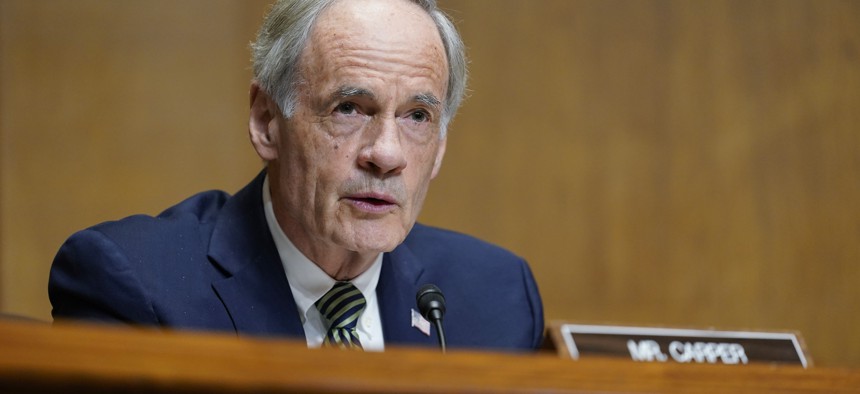A Top Senate Democrat Signals Support for Billions More in Water Quality Grants for States

Sen. Tom Carper, (D-DE), seen here during a hearing in 2021, is supportive of sending more money to states for water projects. Getty Images
But Republican opposition to Biden’s energy policies could thwart the president's hope for a significant EPA funding boost.
The chairman of the Senate’s environment committee on Wednesday hailed President Biden’s proposal to fund billions of dollars in federal water quality grants that were left out of last year’s bipartisan infrastructure act.
“With this budget, President Biden has prioritized the drinking water and wastewater grant programs that are essential to addressing a variety of water infrastructure needs, especially those of small, disadvantaged, Tribal and Alaska Native communities,” said Sen. Tom Carper of Delaware, chairman of the Senate Environment and Public Works Committee.
The comments, given as the committee discussed Biden’s proposal to increase the Environmental Protection Agency’s budget by a fourth, were a positive sign that billions in water quality grants could be headed to states on top of the billions allocated in the infrastructure law.
The Infrastructure Investment and Jobs Act contains $50 billion for water initiatives, including reauthorization of state clean water and drinking water programs at $14.65 billion each over five years. The act also boasts $15 billion for removing lead service pipes through the Drinking Water State Revolving Fund.
But despite what Democrats have described as a “historic” investment, negotiators putting together the infrastructure act left out billions more in funding for a variety of state grants. The grants would have gone toward: reducing lead; doing an inventory of lead pipes; testing for lead in schools; protecting drinking water and wastewater systems from extreme weather; helping cities improve sewer overflow and stormwater reuse; and to train and retain water and wastewater utility workers.
Biden, though, is now proposing to include that money in the budget plan he released last week for the fiscal year starting in October.
“A thriving economy requires clean, safe water for all. While progress has been made, many still face inadequate wastewater systems and suffer the effects of lead pipes,” EPA Administrator Michael Regan told the committee at a hearing reviewing Biden’s funding proposal for the agency.
The grants would come on top of a requirement in the IIJA that about half of the increases in state revolving fund dollars go to disadvantaged communities in the form of grants and forgivable loans. Providing more grants would particularly help smaller or disadvantaged communities that cannot afford to take on more federal loans, Carolyn Berndt, the National League of Cities’ legislative director for sustainability, told Route Fifty in an interview.
However, the money is far from a done deal, noted Carper and the committee’s top Republican, Sen. Shelley Moore Capito of West Virginia.
“As an appropriator, I am fond of saying the president’s budget is aspirational because Congress still retains the power of the purse,” Capito said at the hearing.
Republicans did agree to include the grants in the Drinking Water and Wastewater Infrastructure Act, which passed the Senate in a bipartisan 89-2 vote last year. The revolving fund increases in that act were incorporated in the infrastructure law.
However, despite bipartisan support for the grants, there were warning signs that they could get caught up in Republican anger in the evenly split Senate over the administration’s environmental policies—including those that Capito said would cost coal industry jobs in her state.
“With EPA playing a supportive role in the administration’s assault on our energy and economic security, I think we are right to be skeptical about providing additional funding or authority to the agency until we have a firmer understanding of who is calling the shots and who in the federal bureaucracy should be accountable for the inevitable fallout from these policies,” Capito said at the hearing.
Carper, however, seemed inclined to increase the EPA’s budget, contrasting Biden’s proposal to those by President Trump that would have cut the agency’s budget by 30%. Congress did not go along, but the EPA’s budget remained largely flat during the Trump administration.
The additional funding for the EPA, Carper said, “is vital to rebuilding the agency’s capacity after four years of neglect and failed leadership.” Among the other funds in Biden’s proposal, Regan said, is $100 million to improve air quality monitoring around the country.
Defining Disadvantaged Communities
Regan was also questioned by Capito about whether the EPA would override the will of states, particularly in determining what communities are considered disadvantaged. About half of the state revolving fund dollars are required under the infrastructure act to go to disadvantaged areas, and states are supposed to define what that means.
However, Capito, as did a former Trump EPA official in a separate hearing before the committee on Tuesday, expressed concern that the agency included specific suggestions for defining the term in a March 8 guidance to the states on using the IIJA water funds, including that they have a poverty rate of greater than 20%.
Regan, though, said suggestions were included in the guidance because some states had asked the EPA to be “more specific” in defining the term.
Capito noted the White House has come up with a draft definition that will be used to implement Biden’s goal of making sure 40% of the benefits of federal funds addressing issues like climate change, affordable housing, health care and workforce development go to communities historically left out of getting funding.
She said a first take at identifying what communities are disadvantaged, which could be used in awarding the EPA grants, left out Institute, West Virginia, a low-income, diverse community next to a chemical plant in her state.
She said she worried that even if they were just suggestions, states could lose out on grants if they did not follow the recommendations.
“Why wouldn’t you let the states make that decision?” she said.
Kery Murakami is a senior reporter for Route Fifty.
NEXT STORY: IBM launches AI-accelerated, ‘quantum-safe’ mainframe






